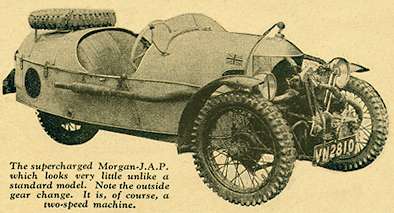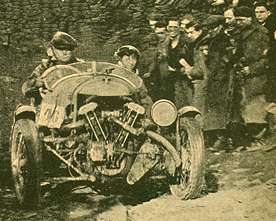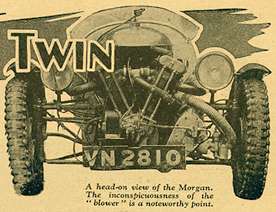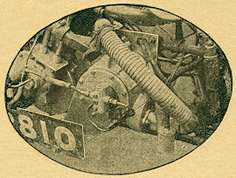Dieser Bericht wurde veröffentlicht von:
Motor Cycling
Mittwoch, 17. April 1935
Seite 764 und 765
All-round Motoring with a Road-Going Supercharged Twin
How an Ordinary Big Twin Morgan Reacted to Blowing

The supercharged Morgan J.A.P. which looks very little
unlike a standard model. Note the outside gear change.
It is, of course, a two-speed machine.
A MACHINE that combines the docility and flexibility of a fluffy side-valve with the performance of a T.T. 500 and the
acceleration of a dirt-track twin sounds altogether too good to be true - in fact, "the ideal model" hot from the Correspondence columns.
Yet such a machine actually exists and is used daily on the roads of Derbyshire and elsewhere. Its engine is an ordinary 1,100 c.c. water-cooled
o.h.v. J.A.P. of 1931 vintage, and the machine itself is Mr. Henry Laird's Super-Sports Morgan. The Morgan's remarkable characteristics mentioned
are all derived from the fitting of a Zoller compressor and it can therefore claim to be the only road-going big twin which is "blown."
In the past, of course, and at present too, supercharged engines have been used on the track, but they represent very different jobs to Mr. Laird's
J.A.P., which, as well as being used on the road, has taken him successfully through many trials in different parts of the country; in fact, Mr. Laird has used
the machine for general all-round purposes. He is, of course, a director of M.A. McEvoy, Ltd., the famous Derby supercharger manufacturing concern,
and can, therefore, be accepted as one of the leading authorities on supercharging in this country.
A Straightforward Job
There is absolutely nothing "trick" about the Morgan; the blower is anchored on the near side of the crankcase and is driven by means of a chain and
countershaft. In a quick survey of the machine it is quite possible that the "blower" would be missed altogether - so unobtrusive is it. It blows mixture to
give a theoretical maximum supercharge of 12 lb. per square inch, and it was found possible to raise the top gear of the two-speed chassis from 4.5 to 1
to 3.8 to 1 without losing anything whatever on top-gear acceleration.
The general conception of a supercharged engine is of something very fierce. On the other hand, this Morgan will tick along on top gear, pulling
steadily at 400 r.p.m., from which speed it will accelerate readily up to its maximum of a shade over 90 m.p.h., although fitted with its normal equipment
of lamps, wings, windscreen, spare wheel, and so forth.

The owner, Henry Laird, accompanied by Mrs. Laird,
climbing a difficult hill in a big "open". The tempo-
rary absence of a front number plate will be observed.
To all intents and purposes the supercharger has given the machine two distinct characters; first of all it is a slow, slogging, quiet "potter-bus." Then, given more throttle, it
becomes capable of holding almost any fast car or solo motorcycle on the road! The "blower," of course, is in operation at all speeds, but the "familiar whine of the
supercharger," so beloved of racing-story writers, is quite absent even when the Morgan is going flat out. Due, of course, to the low compression ratio starting is as easy
as with the most amiable two-stroke.
Mr. Laird told us of a test which he carried out on Litton Slack - that notorious Derbyshire test hill. He says that the terrific power which the engine developed enabled
the 1 in 4 slant to be tackled at 35 m.p.h., at which speed the hill seemed almost to flatten out, and the gradient became of no consequence whatever. Main road hills are
simply child's play to the vehicle, and Mr. Laird claims that he has yet to find a normal hill that cannot be surmounted on top with ease.
Having read this account of hyper-super -performance the sceptic is liable to raise questions of reliability and running costs. We are informed that reliability remains
unaffected; in fact, one might say that it has been improved by supercharging the engine. This is claimed to be due to the fact that the Morgan, when supercharged, runs at
a much lower engine speed and has much smoother power production. So far as fuel consumption is concerned, at an average speed of 40-45 m.p.h., it is stated to be between
30 and 35 m.p.g. - a figure which can hardly be beaten by the average normal big twin of similar capacity.
Speed and Economy
Mr. Laird, as an example of the machine's capabilities, described a run which was recently taken to the Lake District. A distance of 98 miles was covered in 1 hour 55 minutes,
during which distance only three gallons of petrol were consumed and one pint of oil was used for the engine and "blower."
A few weeks ago, on the occasion of the Cotswold Trial, a member of the staff of Motor Cycling had the opportunity of taking a trip in the passenger's seat of this
amazing machine. Used as he is to performances which are definitely on the higher scale, he was immeasurably impressed by the turnout.
Let his own words convey these impressions: -
"Imagine yourself tootling along a gloriously straight stretch of highway at about 70 m.p.h. in a very rakish, trials-equipped Morgan. The man at the wheel turns to
you and, in a most matter-of-fact way, says: "Would you like to go really quickly?" You nod an affirmative. He puts his foot down hard on the accelerator and instantly
you get a kick in the back that amazes you with its suddenness and force.

(Right) A head-on view of the Morgan. The inconspicuousness of the "blower" is a noteworthy point.

(Left) The Zoller compressor which wrought such a change in the character of Mr. Laird's Morgan. The flexible metallic tubing is the long induction pipe along
which the compressor blows the mixture.
"If you want to experience the wonderful thrill of doing this, then try to get a ride with Henry Laird, in his supercharged Morgan, a description of which you have just been
reading. I had a taste of it on the Sunday after the "Cotswold," and it was one of the best hour's motoring I have ever had.
"The machine would amble along in a most sedate and gentlemanly manner, but immediately the throttle was opened to any appreciable extent the outfit became the
most wonderful mile-cater on three wheels that I have ever come across. Its acceleration was literally stupendous, both from low speeds and even when doing over 75 m.p.h.
Smooth Power
"Another feature which greatly impressed me was the smoothness of the power unit. It ran more like a four-cylinder job than a twin throughout its range. Even when
accelerating sufficiently quickly for the rear tyre to leave a black mark on the road, no trace of harshness or snatch could be felt.
"With such a magnificent model to play with, I can well understand, the great enthusiasm Henry Laird and his wife have for our sport. Mrs. Laird, incidentally,
accompanies her husband on all the trials in which he competes. Small wonder, too, that spectators on hills are always impatient for the arrival of this trio."
Enthusiasts will see in this Morgan something for which their hearts have yearned for years. Undoubtedly it is one of the most remarkable three-wheelers which have
ever appeared on the road, and its success in the spheres in which it has been extensively used by Mr. Laird has proved that supercharging has possibilities probably
undreamed of by the ordinary man.
Of course it must not be thought that supercharging is a cheap process. It cost quite a bit of money to "blow" the Morgan and much water will flow under the bridges
before it is likely that machines with superchargers will be available at prices within the reach of everyone. Nevertheless, all motorcyclists who have any interest in the
development of power output will read the foregoing with keen attention.
| Bemerkung: Der Super Aero von Henry Laird namens "Red" hat bis heute überlebt und wird von Larry Ayers regelmässig und mit grossem Erfolg bei Rennen in den U.S.A. eingesetzt. In unserm Photo Album Nr. 8 befinden sich Bilder von "Red", die während eines Rennens in Buttonwillow im Mai 2000 aufgenommen wurden. Wer "Red" einmal live bei Rennen sehen möchte kann sich bei uns unter Termine und Forum über die Rennszene in den U.S.A. informieren. |


Sind Sie durch die Hintertür gekommen und jetzt fehlt die Navigationsleiste?
 Wenn Sie auf der linken Seite keine Navigationsleiste vorfinden, ein
Klick auf den "Homepage & Index"-Button genügt und unsere Homepage mit den Links wird geladen!
Wenn Sie auf der linken Seite keine Navigationsleiste vorfinden, ein
Klick auf den "Homepage & Index"-Button genügt und unsere Homepage mit den Links wird geladen!





